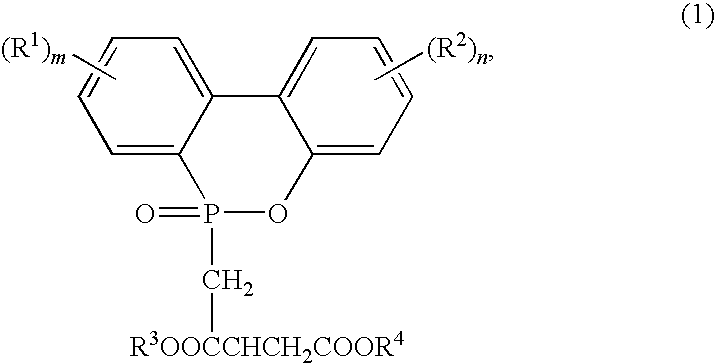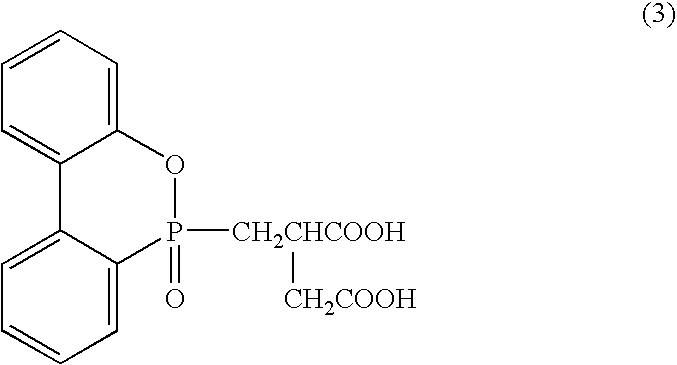Oxetane-containing resin, as well as an adhesive and a resist agent using the same
a technology of oxetane-containing resin and resist agent, which is applied in the direction of adhesives, adhesive types, polyurea/polyurethane adhesives, etc., can solve the problems of poor flame retardant performance, poor heat resistance, and poor heat resistance of hardened products, and achieve excellent heat resistance, excellent flame retardant properties, and high cross-linking density
- Summary
- Abstract
- Description
- Claims
- Application Information
AI Technical Summary
Benefits of technology
Problems solved by technology
Method used
Image
Examples
example 1
[0077]A hydroxyl-terminated polyester resin (A) where molecular weight was 4,000 (100 parts), 33 parts of benzophenone tetracarboxylic acid dianhydride, 10 parts of 3,3-bis(hydroxymethyl) oxetane (BHO), 0.2 part of 4-dimethylaminopyridine as a reaction catalyst and 143 parts of 1,3-dioxolane as a solvent were added into a reactor equipped with stirrer, thermometer and cooler for flowing-out and dissolving and reaction of the resin were carried out at 60° C. for 10 hours. A part of the resulting solution was dried in vacuo at 50° C. to give a resin for analysis. Result of the measurement for the resin is shown in Table 1.
[0078]The resulting solution was applied to a biaxially elongated polypropylene film so as to make the thickness after drying 25 μm and dried with hot air at 100° C. for 10 minutes. The adhesive was released from the film, sandwiched between 18-μm electrolyzed copper foils and adhered by pressing at 150° C. for 30 minutes with the pressure of 5 kg / cm2. Release streng...
example 2
[0079]Hydroxyl-terminated polyester resin (A) where molecular weight was 4,000 (100 parts), 22 parts of benzophenone tetracarboxylic acid dianhydride, 10 parts of di[1-hydroxymethyl (3-oxetanyl)]methyl ether, 0.2 part of 4-dimethylaminopyridine as a reaction catalyst and 132 parts of 1,3-dioxolane as a solvent were added to the same reactor as in Example 1 and dissolving and reaction of the resin were conducted at 60° C. for 10 hours. Evaluation of the resin and evaluation of the adhesive force were conducted in the same manner as in Example 1. Result is shown in Table 1.
examples 3 to 5
[0080]Resin was polymerized in the same manner as in Example 1 using the materials mentioned in Table 1. Evaluation was conducted in the same manner as in Example 1. Result is shown in Table 1.
PUM
| Property | Measurement | Unit |
|---|---|---|
| temperature | aaaaa | aaaaa |
| temperature | aaaaa | aaaaa |
| boiling point | aaaaa | aaaaa |
Abstract
Description
Claims
Application Information
 Login to View More
Login to View More - R&D
- Intellectual Property
- Life Sciences
- Materials
- Tech Scout
- Unparalleled Data Quality
- Higher Quality Content
- 60% Fewer Hallucinations
Browse by: Latest US Patents, China's latest patents, Technical Efficacy Thesaurus, Application Domain, Technology Topic, Popular Technical Reports.
© 2025 PatSnap. All rights reserved.Legal|Privacy policy|Modern Slavery Act Transparency Statement|Sitemap|About US| Contact US: help@patsnap.com



